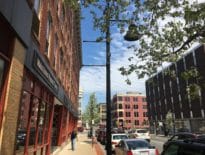Two years on, it’s starting to look like Boston’s Plan JP/Rox may be best remembered as a failure.
A plan intended to let one of Boston’s last affordable neighborhoods along the southern end of Washington Street and the Orange Line grow without displacing current residents instead created an incentive structure where developers can’t build the volume of affordable units needed to keep rents in check. Amid activists’ demands for a 100 percent affordability requirement and other, similar reactions to gentrification, planners chose to use density bonuses to encourage developers to build projects with more affordable units than the citywide 13 percent minimum.
“There’s kind of a belief that the JP/Rox study has greatly increased the availability of density, where in actuality it’s still pretty much capped at three to four stories” by the plan’s affordability requirements, Clifford Kensington, acquisitions manager at Brookline-based City Realty told Banker & Tradesman Associate Editor Steve Adams.
Perhaps in response to this assumption, development parcels have been snapped up throughout the plan’s area at what one observer called “huge quantities money.” Now, these new owners face the reality of trying to get city approval for high-end projects that have no hope of meeting the aspirations laid out in Plan JP/Rox, and risking denial of their zoning variances.
It’s a scenario no one in City Hall should relish if they believe in striving for more equitable development patterns in Boston.
Some of the blame lies at the feet of city leaders. With no one standing up for a compromise solution while the plan was being debated, fantasies of locking market-rate developers out of the neighborhood were allowed to triumph over market realities.
What if a coalition was assembled allowing smaller, 3- and 4- story multifamily buildings everywhere in the neighborhood alongside taller projects in certain areas, like Kensinton’s planned Green Street project? The world will never know, because the controversy over the plan appears to have made turning its recommendations into real zoning politically radioactive.
Of course, not all the blame can be laid at the feet of Boston’s politicos and activists.
While Egleston Square area’s proximity to the Orange Line and the strong demand for city living are helping drive development, the too-damn-high rent would be much lower if Boston’s suburbs pulled their own weight in hosting affordable and market-rate housing. Boston and other core cities cannot carry the entire state on this issue.
Fortunately, Gov. Charlie Baker has put a measure on the table that can start the ball rolling on better housing statewide housing policy. Anyone who is distressed by the situation in Egleston Square should be clamoring for Baker’s “Housing Choice” bill, which would make it much easier to pass pro-housing zoning statewide, to pass the state legislature immediately. It is no silver bullet, but more progressive land-use policies will be much more difficult to pass without it.




 |
| 

